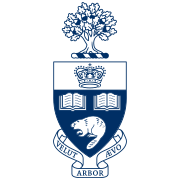Spring of 2018
Course outlines
Description
2017-2018 Timetable Description
First order ordinary differential equations: Direction fields, integrating factors, separable equations, homogeneous equations, exact equations, autonomous equations, modeling. Existence and uniqueness theorem. Higher order equations: Constant coefficient equations, reduction of order, Wronskian, method of undetermined coefficients, variation of parameters. Solutions by series and integrals. First order linear systems, fundamental matrices. Non-linear equations, phase plane, stability. Applications in life and physical sciences and economics.
- Prerequisite: (MAT135H1, MAT136H1)/MAT137Y1/MAT157Y1, MAT223H1/MAT240H1
- Corequisite: MAT235Y1/MAT237Y1/MAT257Y1
- Exclusion: MAT267H1, MAT212H5, MAT258Y5
- Distribution Requirements: Science
- Breadth Requirements: The Physical and Mathematical Universes (5)
Textbook:
William E. Boyce, Richard C. DiPrima, Douglas B. Meade.
Elementary Differential Equations and Boundary Value Problems, Enhanced eText, 11th Edition
In Canada it is available as electronic resource only; printed editions (hardcover or paperback) are not available (unless by premium price).
Meanwhile 10th Edition is out of print.
There are two different books ("with Boundary Value Problems" and without them; the second one is simply a shorter version but it costs the same; BVP for ODE are usually addressed in PDE (Partial Differential Equations) class).
In comparison with 10th Edition, 11th has an additional author. Usually the main difference between edition is that the problems are shuffled; so their numeration differ. Home assignments will use numbers from the textbook. This makes older editions unusable for home assignments.
We will cover (in full or partially) chapters 1, 2, 3, 4, 5, 7 and 9:
- Introduction
- First-Order Differential Equations
- Second-Order Linear Differential Equations
- Higher-Order Linear Differential Equations
- Series Solutions of Second-Order Linear Equations (?)
-
The Laplace Transform
- Systems of First-Order Linear Equations
-
Numerical Methods
- Nonlinear Differential Equations and Stability
-
Partial Differential Equations and Fourier Series
-
Boundary Value Problems and Sturm-Liouville Theory
Note:
Chapter 5 will be covered (if at all) at the very end of the course.
This class in the previous years (as I taught)
Other
WolframAlpha
ODE Plotters
Tests
- Term Test 1 (2 hours long)
Tue, Feb 13, 20:00— 22:00, EX 100 and EX 200.
- Term Test 2 (2 hours long)
Tue, March 20, 20:00— 22:00, EX 100 and EX 200.
There will be early/late sittings (TBA).
We plan to give 7 Quizzes drawn from the Home Assignments, each worth 4 points, worth together 20 points. They will be offered either on the Lectures, or on Tutorials (the arrangements could differ for different quizzes).
If we reduce the total number of quizzes to 6, each will be 5 ponts worth.
Home assignments are neither submitted nor graded but Quizzes will be drawn from Home assignments which are due, Quizzes are usually biweekly and are 15—20 min long in class time, see Lecture Notes which cover also Home assignments and Quizzes.
Your Final Mark will be computed as follows:
\begin{gather}
\mathsf{FM}= \min\bigl[ \mathsf{Q} + \mathsf{BM}+\mathsf{T}_1 + \mathsf{T}_2 + \mathsf{FEM},\, 100\bigr],\\[3pt]
\mathsf{Q} = \mathsf{Q}_1 + \mathsf{Q}_2+\mathsf{Q}_3 + \mathsf{Q}_4 + \mathsf{Q}_5 + \mathsf{Q}_6 + \mathsf{Q}_7 \qquad \text{with 2 worst Quizzes dropped}
\end{gather}
where $\mathsf{FM}$ and $\mathsf{FE}$ are your Final Mark, and the Final Exams Mark respectively,
- $\mathsf{T}_1$ and $\mathsf{T}_2$ are your Test 1 and Test 2 marks (each of these tests is worth 20 points),
- $\mathsf{Q}_n$ are Quiz marks (each 4 points worth), $n=1,2,\ldots,7$,
two worst of them is dropped, so $\mathsf{Q}$ is 20 points worth,
- $\mathsf{BM}$ is the bonus mark calculated as
$\mathsf{BM}=\min (\mathsf{B}_{\text{class}}^{\text{Lec}}+\mathsf{B}_{\text{class}}^{\text{Tut}}+\mathsf{B}_{\text{web}},8)$, where
- $\mathsf{B}_{\textsf{class}}^{\text{Lec}}$, $\mathsf{B}_{\textsf{class}}^{\text{Tut}}$ and $\mathsf{B}_{\textsf{web}}$ are the bonus points for the activity in the class (during lectures and tutorials, respectively) and contributions to the forum.
- $\mathsf{FEM}$ is a Final Exam Mark, 40 points worth.
Missing work
- There will be no make up (even) for a legitimately missing work, but the remainder will count heavier. Namely: $\mathsf{T}_1 + \mathsf{T}_2 + \mathsf{FEM}$ will get factor
$80/(80-L)$ with $L$ the sum of all legitimately missed tests.
- Similarly $\mathsf{Q}$ will get a factor $20/(20-LQ)$ with $LQ$ the sum of all legitimately missed quizzes.
- Since there will be early and late sittings for Tests and since Quizzes are during class time you need to provide a Verification of Student Illness or Injury form covering the day of the missing test.
- You may email to me (not your section instructor) a scan of this form when you receive it, but then you need to bring me the original .
Remarks
- You can go to any instructor during his office hours.
- You may enroll into any section but you need to stick with your choice.

